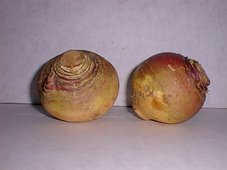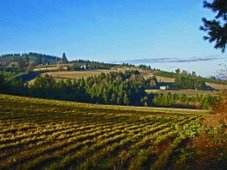With a special tip of the hat to our friend Inger, a rutabagan from Sweden.
Friday, March 30, 2007
Sunday, March 25, 2007
Tuo on paskapuhette
 In the "Finnish Journal of Ethnobotanical Studies" for April, University of Jyväskylä Professor Vittu Perkele Jumalauta suggests that preliterate rutabaga cults may have contributed significantly to early oral versions of "The Kalevala," the Finnish national epic poem (first published in 1835).
In the "Finnish Journal of Ethnobotanical Studies" for April, University of Jyväskylä Professor Vittu Perkele Jumalauta suggests that preliterate rutabaga cults may have contributed significantly to early oral versions of "The Kalevala," the Finnish national epic poem (first published in 1835).Professor Jumalauta provocatively concludes: "Tuo on paskapuhette! Seuraavan tulosopimuksen tekoon potkaistiin varovasti alkuvauhtia maanantaina, kun hallitus ja työmarkkinoiden keskusjärjestöt sopivat aloittavansa yhteisen pohjustavan valmistelutyön sopimusta varten. Työmarkkinajohtajien ja pääministeri Paavo Lipposen (sd) tapaamisessa ei selvinnyt, ovatko järjestöt valmiit käymään sopimusneuvottelut hyvissä ajoin ennen vuodenvaihdetta" [pp. 514-15]
Hannu Ahokas, the great Finnish ethnobotanist, elaborates: "Tutkimusassistenttina ja vanhempana tutkijana sekä kasvigenetiikan dosenttina vuodesta alkaen. Nykyisin hän toimii kasvinjalostustutkimuksessa Maa- ja elintarviketalouden tutkimuskeskuksessa Jokioisissa. Viimeisimmistä julkaisuista esimerkkeinä proteiinikemian metodinen julkaisu sekä monitieteelliset artikkelit, jotka käsittelevät muinaissuomalaisten kansojen kasvinviljelyä ja Kymijoen vesien purkautumisen historiaa Salpausselän yli."
GRAPHIC: Ilmari (or "Ilmarinen"), a character from the Kalevala, sowing rutabaga seeds.
Sunday, March 11, 2007
The nutritional leader
The busy laboratories of the American Root Farmers Federation (ARFF) have confirmed the findings on the nutritional content of certain root vegetables previously reported in The Complete Book of Vitamins and Minerals for Health, published by Prevention magazine. And once again, the rutabaga triumphs easily over its competitors. The specifics follow:
VITAMIN C [mg. per 1/2-oz. serving]:ARSI studies have also found that the rutabaga is rich in a multitude of trace elements that don't naturally occur among its competitors, including: proactinium, osmium, unilloctium, strontium, dysprosium, antimony, praseodymium, gadolinium and yterrbium. The lanthanide and actinide series are abundantly represented as well
18.60 - Rutabaga
06.45 - potato
04.68 - beet
09.05 - turnip
CALCIUM [mg. per 1/2 oz. serving]
36.00 - Rutabaga
27.00 - potato
09.00 - beet
17.15 - turnip
DISCLAIMER: ARSI neither warrants nor implies any health benefits arising from the presence of trace elements, actinides or lanthanides in rutabaga.Here's some additional nutritional data for 100 grams or 3.5 oz. of rutabaga, as compiled by the good folks at Vegetarians in Paradise in their article Rutabagas - An Uncommon Treat:
| Nutrient | Cooked | Raw |
| Calories | 39 | 36 |
| Protein | 1.3 g | 1.2 g |
| Total Fat | .6 g | .6 g |
| % Calories from fat | 5.1% | 5.0% |
| Carbohydrates | 8.7 g | 8.1 g |
| Fiber | 1.8 g | 2.5 g |
Sunday, March 04, 2007
A cutting issue
 Vexing technical problems continue to hamper efforts to increase the appeal and marketability of the rutabaga. As every recipe demonstrates, the extreme macromolecular densities and mass of the rutabaga guarantee excessive and impractical cooking times for all but the most dedicated rutabagans. However, ARSI's laboratories have taken an innovative look at the problem, resulting in several potential solutions:
Vexing technical problems continue to hamper efforts to increase the appeal and marketability of the rutabaga. As every recipe demonstrates, the extreme macromolecular densities and mass of the rutabaga guarantee excessive and impractical cooking times for all but the most dedicated rutabagans. However, ARSI's laboratories have taken an innovative look at the problem, resulting in several potential solutions:
- A 24,000-watt microwave oven may reduce cooking times to 96 hours for a 2-pound rutabaga;
- An ionic oven, under development at CalTech, could reduce baking time to 16.8 hours;
- Trial "cooking" sessions using the neutron accelerator at Karnac, Illinois, have miraculously reduced cooking times to 8.4 hours.
The latter method, while most efficient, consumes vast amounts of electricity and can produce catastrophic submolecular degradation [i.e., an explosion] if slight "overcooking" occurs. It therefore seems unlikely to produce a short-term solution.
Extended cooking times are only one of many factors which inhibit consumer acceptance of the rutabaga. ARSI studies have shown that cooking times can be reduced (up to 25%) by cutting rutabagas into very small pieces. However, the extreme hardness of the product renders the process of slicing and dicing very laborious and frustrating. With this in mind, ARSI continues its laboratory trials with industrial-grade wood chippers, whose conventional grinding gears are worn out far too quickly to provide a practical means of preparing rutabagas for cooking. A stainless-steel gear with diamond-studded teeth and a titanium core has been fairly effective, but the cost remains prohibitively high. Researchers are now evaluating miniaturized versions of Boreregard, the rock boring machine recently used to construct a light-rail tunnel in OregonPHOTO: A modified Hiroller 1250 wood chipper with diamond-studded teeth and a titanium core, approved by ARSI in 2006 for use in cutting rutabagas. A much smaller and more economical version, suitable for use in kitchens, is currently under development.
Subscribe to:
Comments (Atom)




